In the past months, we have examined medieval goldwork embroidery centres in Italy and England. This month, we will explore medieval goldwork embroidery made in the Franconia Region in Germany, which lies just south of the centre of Germany. Important cities include Nuremberg, Würzburg, Bamberg, Bayreuth, Ansbach, Coburg, Meiningen and Schwäbisch Hall. As far as I know, there is no literature on medieval embroiderers or the guilds they belonged to from these towns. We do know of two 15th-century Bamberg embroiderers, Friedrich Seidensticker and Jörg Spiß. It is possible that Jörg was Friedrich’s son. As all these centres were quite important during the Middle Ages – either dominated by nobility, clergy or wealthy merchants – professional embroidery production could have taken place in all of them. Let’s examine their products.
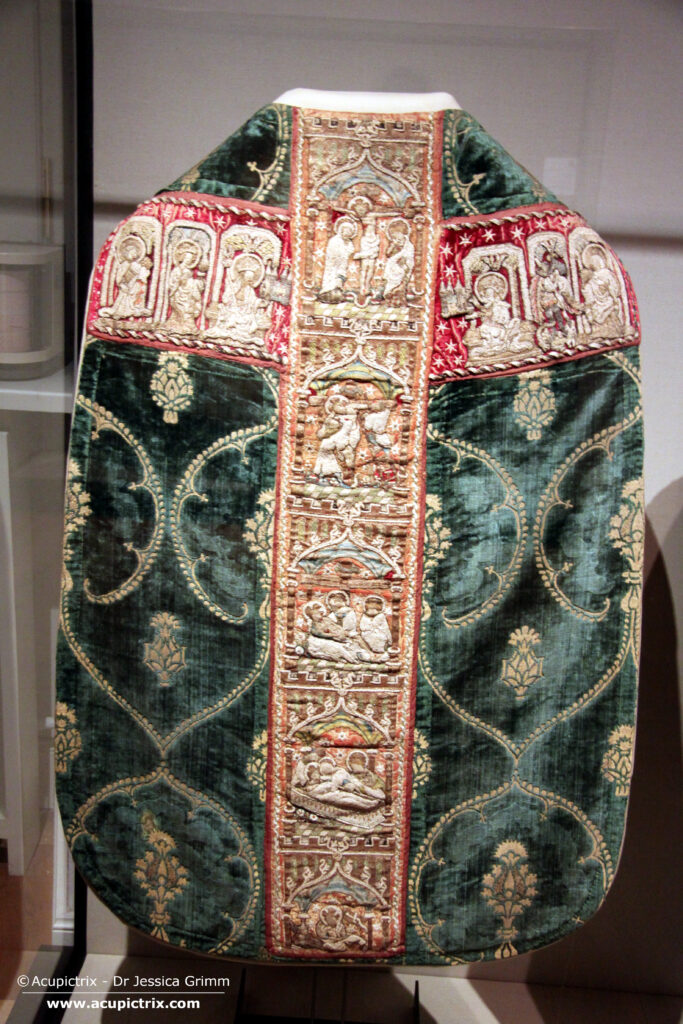
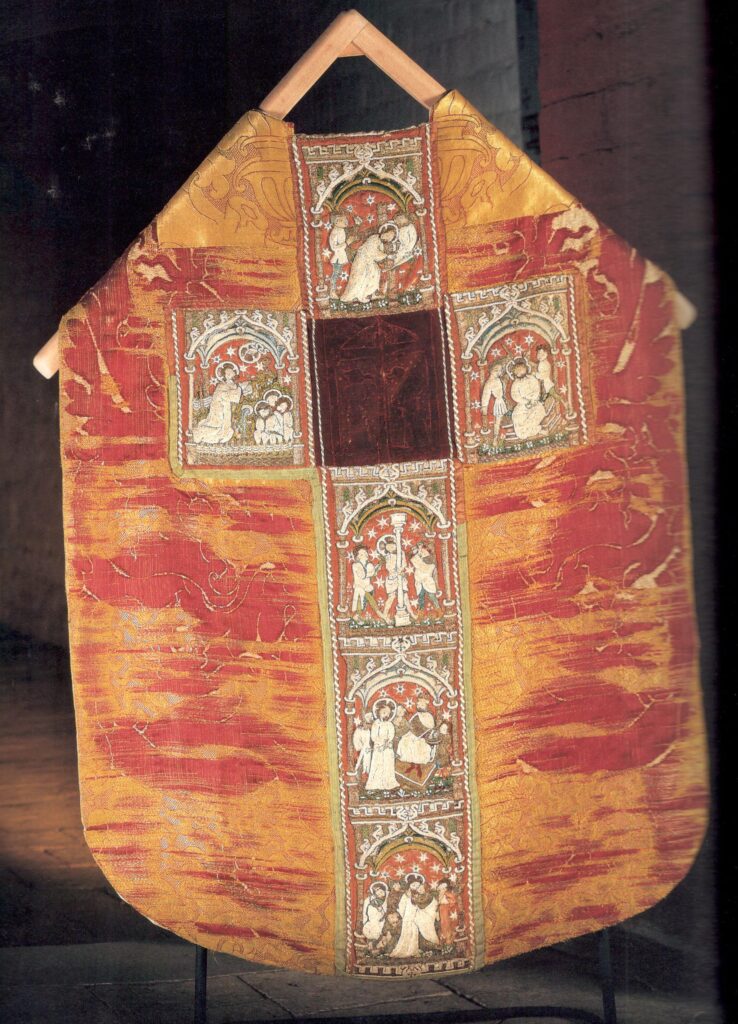
The above green chasuble with medieval goldwork embroidery on its back is kept at the Diocesan Museum in Bamberg. Although I cannot find this piece in the literature, a comparable chasuble from Brandenburg Cathedral has been extensively studied, including details of the materials used. The chasuble cross from Bamberg consists of two different pieces of stumpwork embroidery. The museum thinks that both pieces were possibly made in Franconia.
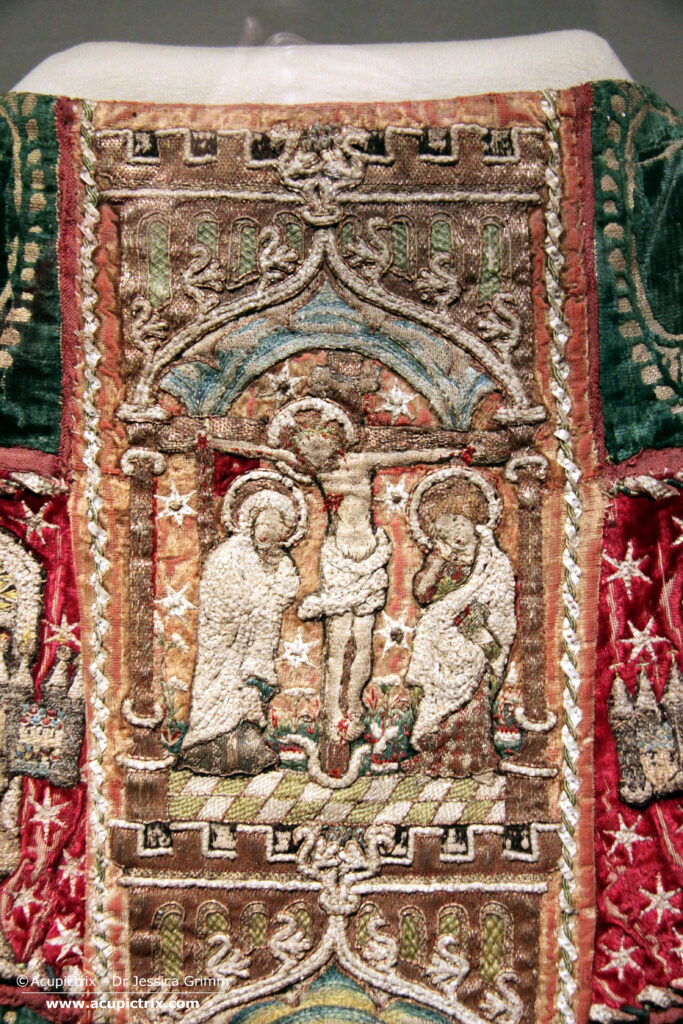
The medieval goldwork embroidery of the central column was made around AD 1420-1430. The scenes show (from the top) the Crucifixion, Jesus being taken down from the cross, the Pieta, the entombment, and the Resurrection. I would count this embroidery as stumpwork, as the figures and some background elements are slightly padded. Some of the padding was done as stuffing during the appliqué, whilst some string padding is used directly onto the linen before stitching. The gold threads are couched down in pairs and are of the gilt silver foil type. The amount of bare white string padding that was once completely covered with freshwater pearls is very high. This means that this embroidery was extremely valuable.
Most of this medieval goldwork embroidery was stitched on linen (c. 46 x 48 ct) and then applied onto the red silken velvet, which is now a bit faded. Other parts, like the little stars and flowers, have been embroidered directly onto the velvet over a parchment padding. The twisted column on the edge of the orphreys consists of a strip of parchment covered initially with pearls and twisted with two strands of green silk gimp.
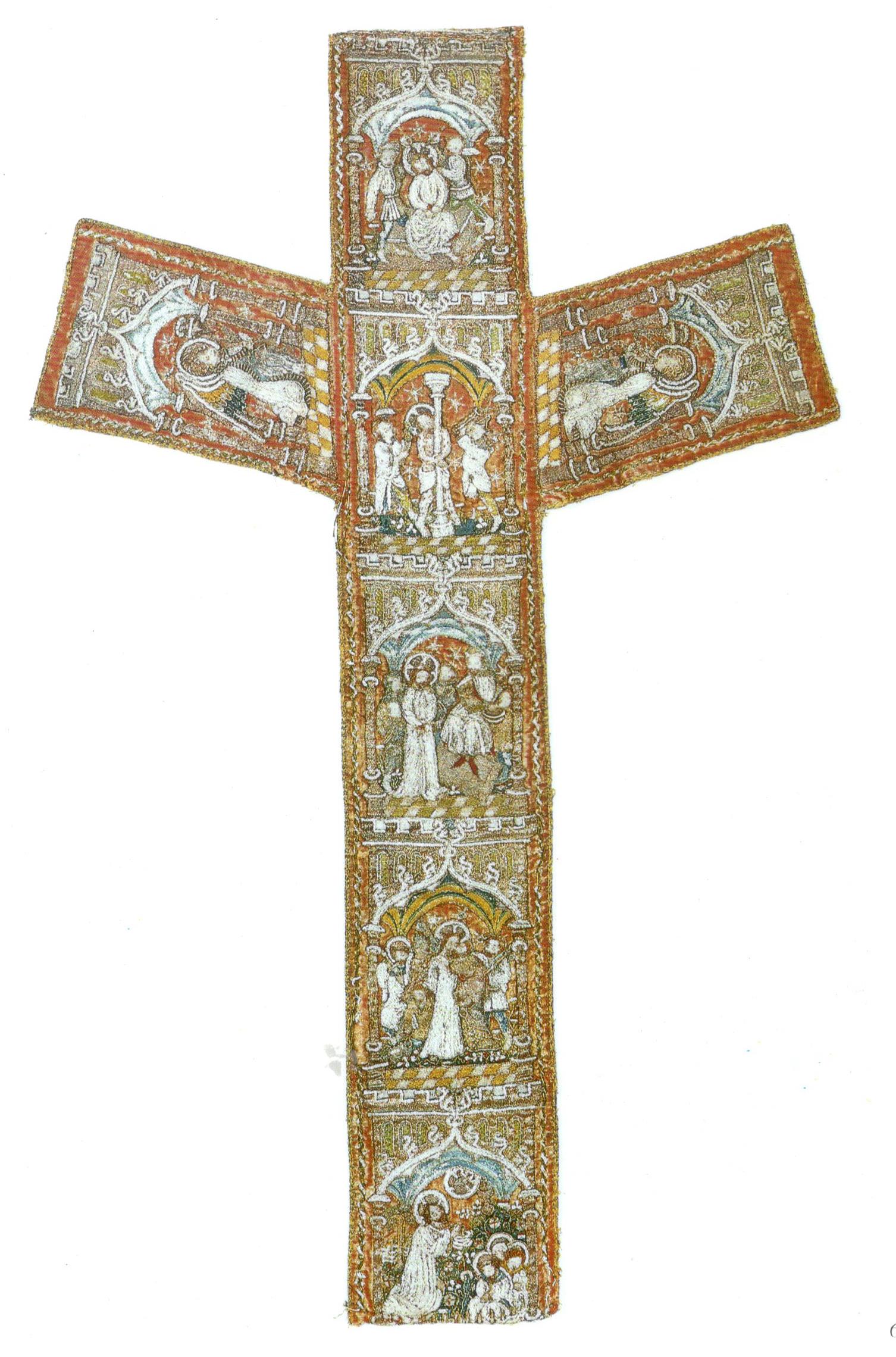
To my delight, I have found other parts of the same medieval goldwork embroidery in a book on the Keir Collection. After all, many more embroidered scenes are needed to tell the complete Passion story and decorate a chasuble properly. This chasuble cross was in the Keir Collection until 1997 and then likely auctioned in New York—its current place of residence is unknown to me. The scenes preserved here are two censing angels in the cross beam, and (from the bottom up) Agony in the garden of Gethsemane, Betrayal of Christ, Christ before Pontius Pilate, Flagellation, and Crowning with thorns. Just as seen on the chasuble in Bamberg, the bottom part of the bottom scene has been cut off. This shows that the original chasuble had been re-made into a shorter, more fashionable shape at some point. It is unknown when the column and the cross were separated. The cross was purchased in Italy in the 20th century.
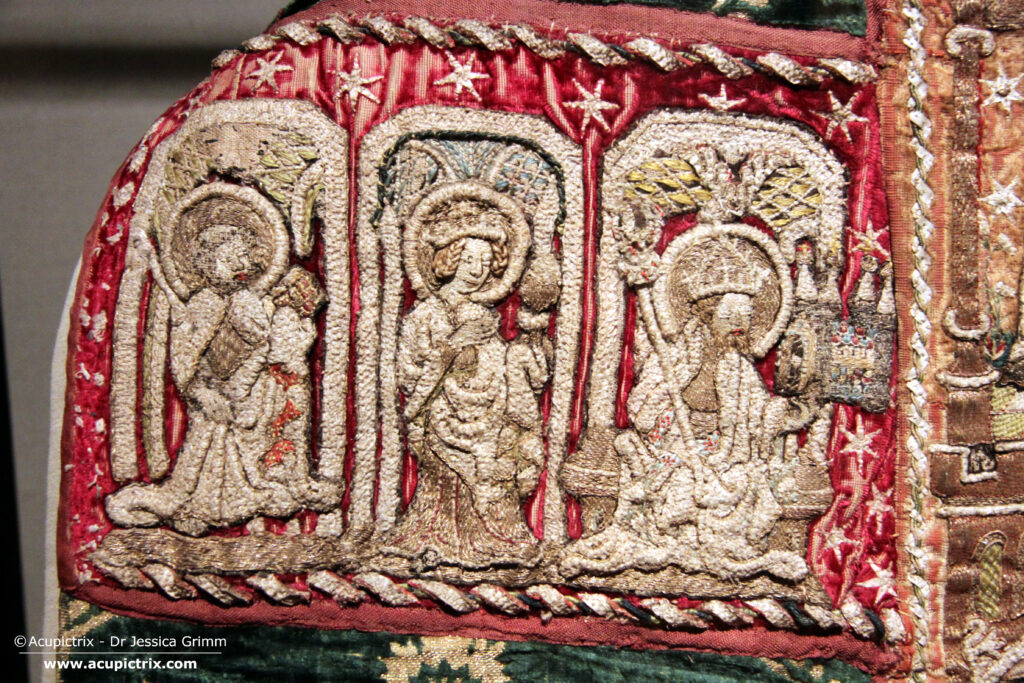
The medieval goldwork embroidery in the cross beam of the chasuble from Bamberg was made a couple of decades earlier, around AD 1400. From left to right we see an Apostle with a book and an elongated attribute, followed by a holy virgin, followed by probably Holy Roman Emperor Henry II holding a model of Bamberg Cathedral, his wife Kunigunde also holding a model of Bambeg Cathedral, Saint George (patron saint of Bamberg Cathedral) and a female saint.
Again, we have a form of appliquéed stumpwork embroidery embellished with many freshwater pearls on red velvet. You can see that whoever joined the two embroideries onto this chasuble has tried to marry them up nicely. They even added the stars in the background and a similar ribbon-like border.
It is impossible for me to tell when the merging of the two embroideries happened. But it was done by a skilled person. The two types of embroidery are similar enough that they nicely complement each other. Were the Bamberg-specific embroideries made in Bamberg to complement the ready-made orphreys possibly made in Nuremberg?
As the Passion scenes on the chasuble from Bamberg are the more important ones (it includes the Crucifixion), this part would also have sat on the back of the original vestment (better visibility for the congregation). The cross in the Keir collection was probably always intended for the front.
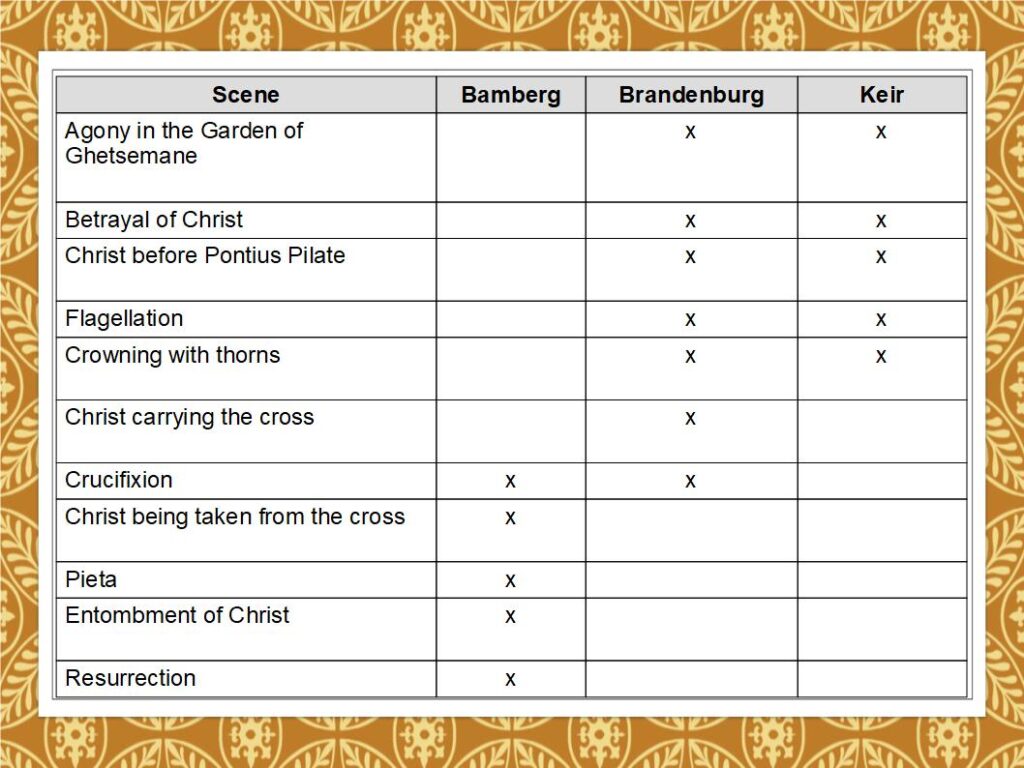
The older embroideries in the crossbeam on the chasuble from Bamberg have imagery clearly related to Bamberg Cathedral, so they are probably part of the original Cathedral Treasury. The above table shows that the embroideries on the chasuble from Bamberg and those in the Keir collection could have come from the same original embroidery. The chasuble from Brandenburg cannot be mixed with any of the other two without producing duplicate scenes. Unfortunately, how the original embroideries ended up in the current three pieces is unknown. What it does show is that these embroideries were of the highest standards and fit for cathedrals.
Literatur
Baumgärtel-Fleischmann, R., 1983. Ausgewählte Kunstwerke aus dem Diözesanmuseum Bamberg. Veröffentlichungen des Diözesanmuseums Bamberg 1. Bayerische Verlagsanstalt GmbH, Bamberg.
Jehle, M., Wetter, E. (Eds.), 2005. Liturgische Gewänder und andere Paramente im Dom zu Brandenburg. Abegg-Stiftung, Riggisberg.
King, M., King, D., 1990. European Textiles in the Keir Collection 400 BC to 1800 AD. Faber and Faber, London.
Kohwagner-Nikolai, T., 2020. Kaisergewänder im Wandel – Goldgestickte Vergangenheitsinszenierung: Rekonstruktion der tausendjährigen Veränderungsgeschichte. Schnell + Steiner, Regensburg.
